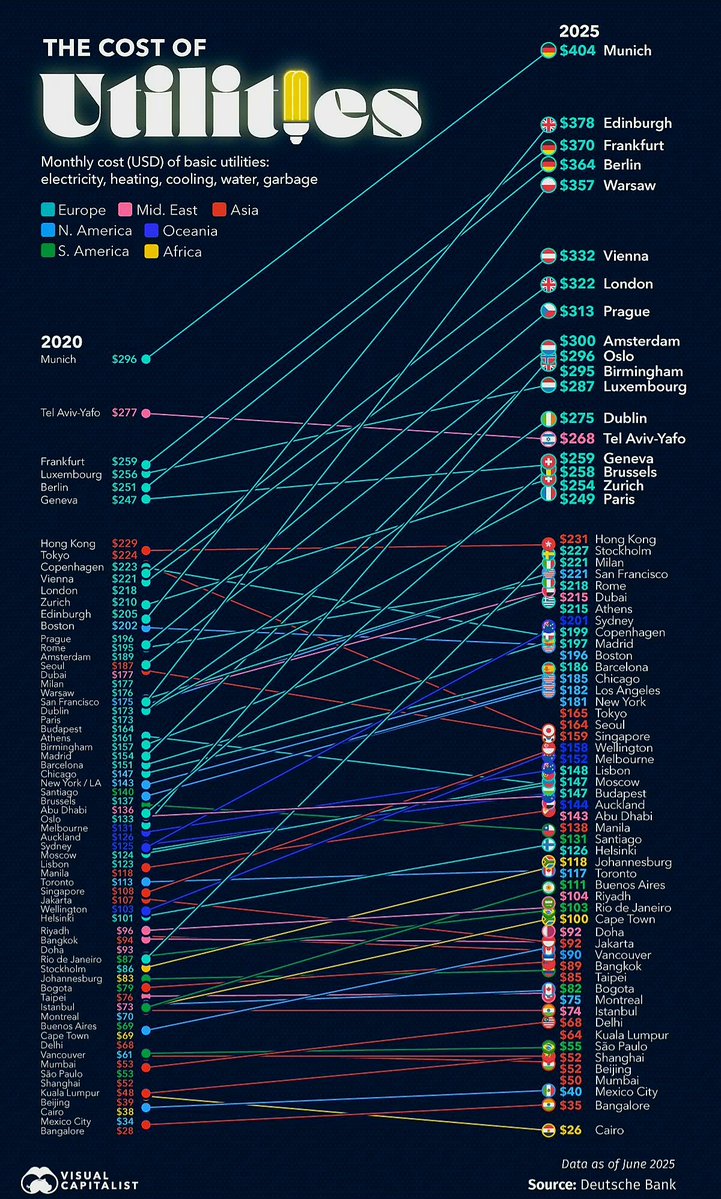Select Language:
Monthly Cost of Utilities Around the World in 2025
1. The United States: An Increasing Trend in Utility Expenses
In 2025, American households are experiencing a noticeable rise in monthly utility bills. The average cost for electricity, water, gas, and internet now totals approximately $350. This marks a 4% increase from last year, primarily driven by inflation, increased energy demand, and the ongoing transition to renewable energy sources. Households in major cities like New York and San Francisco face higher costs, often exceeding $450 due to urban infrastructure expenses, while rural areas typically report lower bills around $250 per month.
2. Canada: Steady Growth Amid Climate Change Initiatives
Canadian residents are paying an average of CAD 320 ($250 USD) monthly for utilities, reflecting a steady growth compared to previous years. Natural gas remains a significant expense, especially in colder regions like Alberta and Quebec. The country’s push toward greener energy has led to increased investments in solar and wind, which have somewhat stabilized costs but haven’t prevented a slight uptick. Water expenses are minimal in most provinces, but internet and electricity dominate the monthly totals.
3. European Countries: Variations Based on Energy Policies
Across Europe, utility costs show considerable variation depending on energy policies and energy sources. Countries like Germany and France generally face monthly bills ranging from €150 to €200 ($165 to $220 USD). The widespread adoption of renewable energy helps keep costs somewhat stable, but countries transitioning away from nuclear and fossil fuels, such as the UK and Spain, are seeing costs rise to approximately €180 ($200 USD). Southern European nations, like Italy and Greece, report slightly lower averages around €130 ($145 USD), mainly due to milder climates reducing heating and cooling needs.
4. Australia: High Energy Prices Reflect Market Fluctuations
In Australia, utility bills are averaging around AUD 250 ($180 USD) a month. The country’s reliance on imported fuels and the volatility of global energy markets contribute to higher prices. Additionally, the push for solar panel installation has increased upfront costs but offers long-term savings. Water bills are comparatively affordable, especially in drought-prone regions where conservation measures are standard. Internet remains competitively priced, with most households paying between AUD 70–100 ($50–$70 USD) monthly.
5. Asian Countries: Diverse Costs Driven by Infrastructure and Policies
Asia exhibits a broad spectrum of utility costs, influenced by economic development and infrastructure quality. In Japan, households pay approximately ¥15,000 ($140 USD) monthly, with electricity and water costs on the rise due to energy shortages and natural disasters. Countries like India and Vietnam enjoy significantly lower rates, averaging $30–$50 USD per month, mainly because of subsidy programs and lower energy costs. South Korea’s higher standard of living pushes average utility bills toward $180 USD, with substantial investments in smart grid technology and renewable energy.
6. Latin America: Costs Remain Relatively Affordable
Monthly utility costs in Latin America generally remain affordable, with averages around $60–$80 USD. Brazil and Mexico lead the region in utility expenses, mainly driven by electricity costs and water tariffs. Countries like Colombia and Argentina benefit from hydropower resources, keeping their overall utility bills below $50 USD. Internet costs are variable, but the expansion of broadband has alleviated some affordability concerns.
7. Africa: Low Utility Costs, But Infrastructure Challenges Persist
In many African nations, utility expenses are modest, often ranging from $20 to $50 USD per month. South Africa’s average bill is around $35 USD, with electricity being the primary expense. The expansion of off-grid solar projects has begun to impact costs positively, especially in rural communities. However, inconsistent supply and unreliable infrastructure continue to pose challenges, leading many households to seek alternative solutions.

Overall Observation
As of 2025, utility costs continue to fluctuate globally, influenced by regional energy policies, infrastructure development, and market dynamics. While some regions see steady increases, others benefit from technological advances and renewable energy integration, helping to stabilize or even reduce costs. Consumers worldwide are increasingly conscious of their energy consumption, prompting investments in energy-efficient appliances and solar installations, which are expected to shape utility costs in the coming years.







